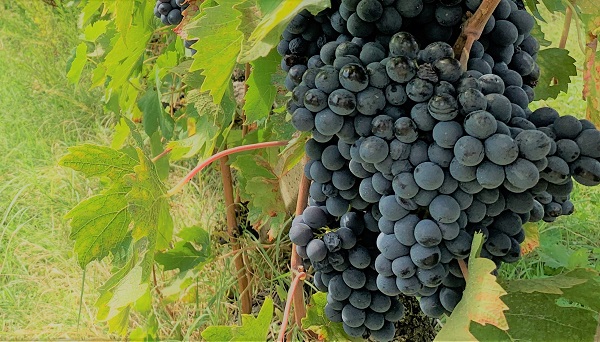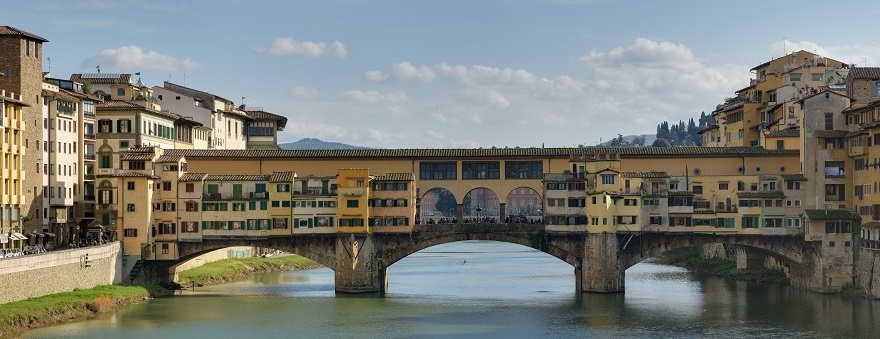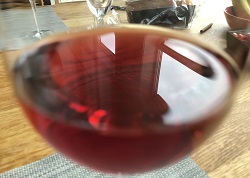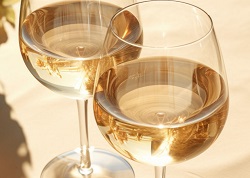Sangiovese Flavors
Primary flavors are Wild Berries, with hints of Herbs (Oregano), Flowers (Violets), Spices.
Red Cherry |
Strawberry |
Raspberry |
Cranberry |
Herbs |
Violets |
Spices |
Tea Leaves |
About Sangiovese
Sangiovese is the most cultivated red grape in Italy where it is planted from North to South, but it is best expressed is in the region of Toscana.
Sangiovese is thin-skinned. The name translates to Blood of Jupiter". The color of the wine is light red.
Sangiovese wine has high acidity, smooth tannins, medium body and medium alcohol.
Red Cherries and Wild Berries are typical Sangiovese flavors, with hints of Flowers (Violets), Licorice, Spices, Tea, and Minerals. With aging, Darker Berries, Sweeter Cherry, Plum, and more Herbal flavors are developed.
Sangiovese Vinification
Alcoholic Fermentation
The first fermentation called alcoholic starts above 16°C (60°F). Sugars are turned into alcohol while carbon dioxide and heat are released.
Alcoholic fermentation usually takes place in vats (steel or cement) where it is easy to control both temperature and speed of fermenation. An error at this stage can result in wine faults.
The pomace (skin+pips) is then pressed and mixed with the fermented must. Now can the second fermentation (malolactic) start.
Malolactic Fermentation (MLF)
Malolactic bacteria consume malic acid (naturally present in the grape) and convert it to lactic acid. MLF is essentially the conversion of malic acid into lactic acid. As a result the wines become rounder, fuller and less acidic. Practically easier to drink and to match with food.
Oak Maturation
After the two fermentations are completed, the wine is separeted from its lees (dead yeast cells) and sulfites are added to protect against oxydation. Now it´s time to sleep! Barrel fermentation, storage, and aging will cause the wine to absorb taste from the wood, like vanilla, caramel, spices, smoke and toast flavors.
Sangiovese DOC(G) Regions
The Sangiovese wines from Toscana (Tuscany) are world famous.
Montalcino, Toscana
Rosso di Montalcino DOC - 100% Sangiovese
- Flavors: Bright red fruit (cherry, strawberry) with hints of spices.
- Body: Medium body. Fresh and approachable
- Intensity: Medium intensity. Young and vibrant with soft tannins.
Brunello di Montalcino DOCG - 100% Sangiovese
- Flavors: Rich red and dark fruits (cherry, blackberry) with earthy, spicy, and smoky undertones.
- Body: Full body. Strong structure and complex flavors.
- Intensity: High intensity. Bold tannins and a long finish due to extended aging.
Montepulciano, Toscana
Rosso di Montepulciano DOC -Min 70% Sangiovese
- Flavors: Fresh red fruit (cherry, raspberry) with subtle earthy notes.
- Body: Medium body. Softer and more accessible than its DOCG counterpart.
- Intensity: Medium intensity. Easy to drink with a mild tannic structure.
Nobile di Montepulciano DOCG - Min 70% Sangiovese
- Flavors: Ripe red fruits, sometimes with hints of leather, herbs, and earthy undertones.
- Body: Full body. Complexity and structure. Tannins are balanced by fine acidity.
- Intensity: High intensity. High aging potential.
Chianti, Toscana
Chianti DOCG - Min 70% Sangiovese
- Flavors: Bright cherry, red plum, and occasionally floral notes with earthy hints.
- Body: Medium body. Vibrant acidity and moderate tannins.
- Intensity: Medium intensity. Balanced, everyday style.
Chianti Classico DOCG - Min 80% Sangiovese
- Flavors: Deeper cherry and dark berry flavors with herbs, leather, and spice.
- Body: Medium to full body. Rounder and more complex than CHianti DOCG.
- Intensity: High intensity. Structured with firm tannins and higher aging potential.
Other Toscana Regions
Montecucco Sangiovese DOCG - 90-100% Sangiovese
- Flavors: Dark cherry, blackberry, and earthy notes with a hint of spice.
- Body: Full body. Robust with a solid tannic structure.
- Intensity: High intensity. Bold and concentrated, showcasing power and depth.
Suvereto Sangiovese DOCG - 85-100% Sangiovese
- Flavors: Ripe red and black fruits, with complex, earthy, and spicy undertones.
- Body: Full Body. Rich and rounded.
- Intensity: High intensity. Lush and intense with depth.
Morellino di Scansano DOCG - 85-100% Sangiovese
- Flavors: Juicy red fruit (plum, cherry) with a fresh, floral character.
- Body: Medium body. Smooth and approachable.
- Intensity: Medium to high intensity. Generally more fruit-forward and easy-drinking.
Carmignano DOCG - Min 50% Sangiovese
- Flavors: Red fruit mixed with herbal and slightly earthy notes.
- Body: Medium to full body. Smoother due to the blend with Cabernet.
- Intensity: Medium to high intensity. Balanced with a complex finish.
Emilia-Romagna
Sangiovese di Romagna DOC - 100% Sangiovese
- Flavors: Fresh red fruit (cherry, strawberry) with floral notes.
- Body: Light to medium body. Soft and approachable.
- Intensity: Medium intensity. Generally lighter and more fruit-forward.
Umbria
Montefalco DOC - 60-80% Sangiovese
- Flavors: Red cherry and earthy notes, often with a rustic edge.
- Body: Medium body. Firm structure.
- Intensity: Medium intensity. May be tannic due to blending with Sagrantino.
Torgiano Riserva DOCG - Min 70% Sangiovese
- Flavors: Deep red fruit with earthy and spicy undertones.
- Body: Full body. A refined structure and smooth texture.
- Intensity: High intensity. Rich and complex with aging potential.
Body Summary
Medium Body: Chianti, Sangiovese di Romagna.
Medium to Full: Chianti Classico, Rosso di Montalcino, Rosso di Montepulciano, Morellino di Scansano, Montefalco.
Full Body: Brunello di Montalcino, Nobile di Montepulciano, Montecucco Sangiovese, Suvereto Sangiovese, Torgiano Riserva.
Sangiovese Clones
Based on the work of G. Molon in 1906, Sangioves has been divided in two families: the Sangiovese Grosso (big), used for making Brunello di Montalcino, and Chianti wines, and the Sangiovese Piccolo (small), used in the other zones of Tuscany.
But this classification is too simple. There are nearly 100 approved clones of Sangiovese in Italy and the are no indication that the quality can be based on the size of the grapes.
Terroir
Sangiovese loves the Galestro terroir found in most of Tuscany’s best vineyards.
Galestro was created in a deep sea which is now the Mediterranean. It is a formation of stone, mudstone, sand, and clay (not compact clay), that breaks into little pieces helping open the soil.
Black Grapes |
White Grapes |
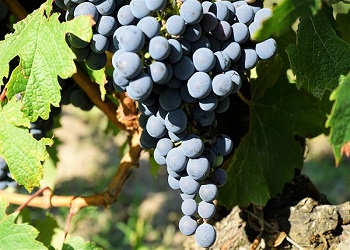
65% Sangiovese |
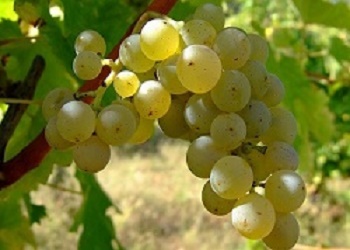
6% Trebbiano |
Rosé Wines |
Sweet Wines |
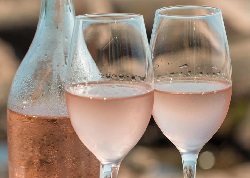
|
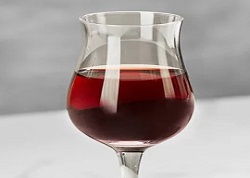
|
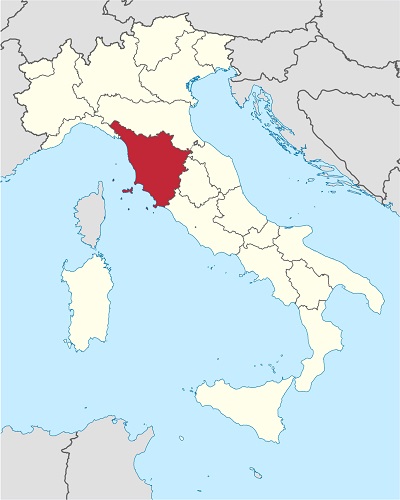
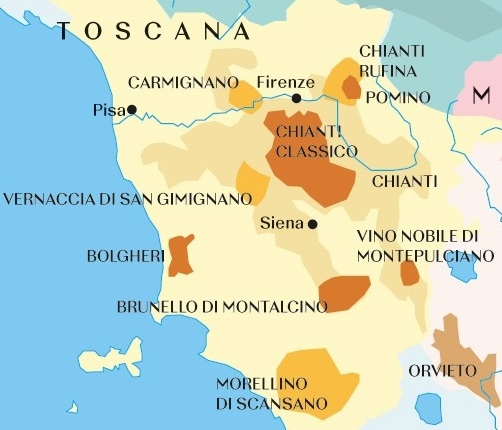
Denominations
Toscana has 11 DOCGs and 41 DOCs. Below is a list of the DOCGs.
Sangiovese:
Chianti DOCG (70% Sangiovese)
Chianti Classico DOCG (80% Sangiovese)
Brunello di Montalcino DOCG (100% Sangiovese)
Vino Nobile di Montepulciano DOCG (70% Sangiovese)
Montecucco Sangiovese DOCG (90% Sangiovese)
Morellino di Scansano DOCG (85% Sangiovese)
Super Tuscan:
Carmignano DOCG (Sangiovese, Cab Sauvignon/Franc, Merlot)
Suvereto Rosso DOCG (Cab Sauvignon, Merlot)
Val di Cornia Rosso DOCG (Sangiovese, Cab Sauvignon, Merlot)
White:
Vernaccia di San Gimignano DOCG (85% Vernatcha)
Passito:
Elba Aleatico Passito DOCG (100% Aleatico)
